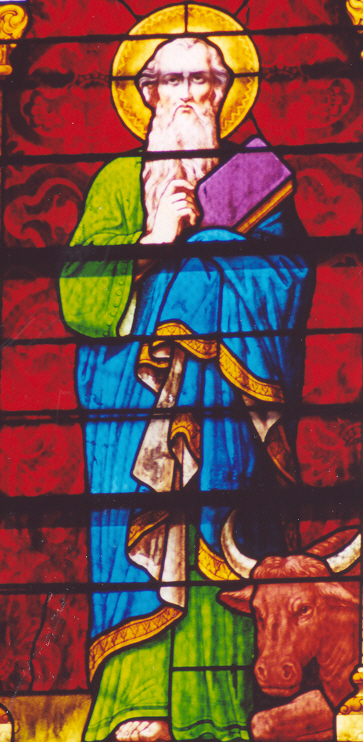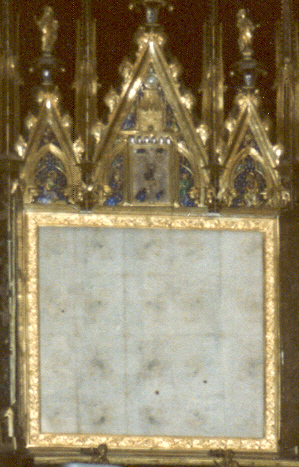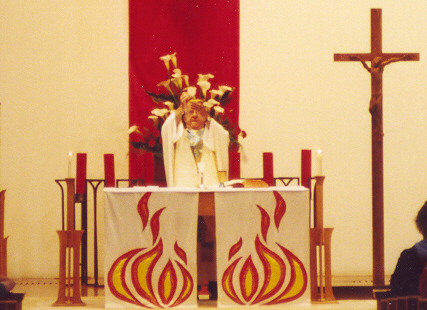
Solemnity of Corpus Christi
A Homily - C Cycle - 2003-2004
(Worshiping the Body and Blood of Christ)
First Reading - Genesis 14:18-20
Psalm - 110:1, 2, 3, 4
Second Reading - 1 Corinthians 11:23-26
Sequence -
Lauda Sion
Gospel - Luke 9:11b-17
Home Page
Luke writes to explain that
Christ came to save everyone.

Jesus spoke to the crowds about the kingdom of God, and he healed those who needed to be cured. As the day was drawing to a close, the Twelve approached him and said, "Dismiss the crowd so that they can go to the surrounding villages and farms and find lodging and provisions; for we are in a deserted place here." He said to them, "Give them some food yourselves," They replied, "Five loaves and two fish are all we have, unless we ourselves go and buy food for all these people." Now the men there numbered about five thousand. Then he said to his disciples, "Have them sit down in groups of about fifty." They did so and made them all sit down. Then taking the five loaves and the two fish, and looking up to heaven, he said the blessing over them, broke them, and gave them to the disciples to set before the crowd. They all ate and were satisfied. And when the leftover fragments were picked up, they filled twelve wicker baskets.
It is the summer of 1804. Pope Paul VI is the Roman Pontiff and Thomas Jefferson is President of the United States. A young and beautiful Episcopalian widow of New York high society sits in St. Paul's Chapel near Wall Street at the typical Sunday service. Yet, she finds herself staring out the window across the street at St. Peter's Catholic church and begins praying to the Blessed Sacrament. You see, she's just returned from Italy and has been heavily influenced by the Eucharistic piety of her Italian Catholic friends. Their witness was the seedbed for this young widow's gradual conversion to Catholicism and it all began with their deep devotion to the Mass and our Eucharistic Lord.

I begin with this story centered on the Eucharist because today, we celebrate the Solemnity of the Most Precious Body and Blood of our Lord Jesus Christ - otherwise known as Corpus Christi. It's a Solemnity that dates back all the way to the 13th century. A priest at the Church of St. Cristina in the small Italian town of Bolsena, not far from Orvieto, about 75 miles north of Rome, had lost faith in the Real Presence. He no longer believed that it was really Jesus - body, blood, soul and divinity, whom became present on the altar at the consecration. One morning, as he was saying Mass, the host he had just consecrated began to bleed on one of the linens on which he placed the host. Pope Urban IV sent St. Thomas Aquinas to authenticate this miracle and to this day, the linen hangs in the Cathedral of Orvieto and to this day, we still sing the same song St. Thomas Aquinas composed for this occasion - it's the sequence we heard just before the Gospel was proclaimed. The hymns O Salutaris and Tantum Ergo, which we sing for Exposition and Benediction of the Blessed Sacrament were written by St. Thomas Aquinas. Pope Urban IV had commissioned both St. Thomas Aquinas and St. Bonaventure to write the Office and the Mass for Corpus Christi, from which he would chose one to promote throughout the Church. When Aquinas presented his Mass setting, Bonaventure was so moved that he ripped up his own text and conceded that Thomas had expressed what he had tried so hard to find words for but could not.
Finding words for the miracle of the Eucharist leads us to appreciate what is really a double miracle. The first miracle is the changing of the bread and wine into the body and blood of Christ. The second miracle is that although the substance has changed, the appearances remain that of bread and wine and DON'T appear as flesh and blood as they did in Bosena, such that the appearances remain but nothing of bread and nothing of wine are present. Normally, when a substance changes, such as when fire burns a piece of paper into ashes, we expect the paper to now take on the appearance of ashes because a change has occurred. In the Eucharist, a substantial change occurs and yet the appearances of bread and wine remain - truly remarkable.

Is this too incredible to believe? Not at all. If Jesus Christ was true man and true God - and we know God CREATED the entire universe by His mere word, then what is to stop us from believing that the SON of God could transform bread and wine into His own body and blood by His word?
On a practical level, allow me to suggest a few concrete ways for us to increase our Eucharistic piety and devotion:
1. Preparation - get to Mass on time; remain silent and still before Mass; place your intentions for the Mass on the paten that Father holds. IF you must go to confession, GO! You should not receive communion with mortal sin on your soul. That is a sacrilege and St. Paul says that he who receives the Eucharist unworthily is GUILTY of the Body and Blood of Christ.
• Do we keep the Eucharistic fast of one hour? No gum chewing should occur in church.
• Are we properly dressed for Mass? It is well-known that country clubs and certain fine restaurants have dress codes. The banquet that we participate in each Sunday is far more prestigious. Does our dress reflect our reverence for the Eucharist or does it really reflect our lack of faith and respect?
2. Reception - are we truly aware of exactly what is happening and who we are receiving at Mass. If we receive on the hand, do we do this correctly?
3. Staying in our pews until the Mass ends - some of us call leaving early, "The Judas Shuffle." As you know, Judas left the First Mass early - the Last Supper. Not a good example of how to conduct oneself at Mass.
4. Thanksgiving - after Mass, do we even bother to kneel in silent prayer as the documents of Vatican II commend, in order to offer thanks to God for the great gift we have received. We are all walking tabernacles for about 15 minutes after Mass. St. Alphonsus Ligouri used to have altar boys follow persons who would leave Mass early with candles to remind them that the Blessed Sacrament was still present in their bodies!
5. We ought to keep silence in church after Mass out of respect for the Blessed Sacrament. The church ought not turn into a social hall. After all, the end of Mass does not mean that the Real Presence ceases to linger in the tabernacle.
6. Acts of piety - making the sign of the cross when passing by the church. Making visits after work or after school. Jesus is here and HE THIRSTS for your love.
You'll recall that I began my homily with the story of the Episcopalian woman who was impressed by the Eucharistic piety she saw in Italy. That woman turned out to be St. Elizabeth Ann Seton - the first American-born saint. Just two years after that trip to Italy, Elizabeth - now a widow - was received into the Catholic faith. It all began with a special grace given to her to appreciate and develop a love for the Eucharist. You see, for Mother Seton, Catholicism was not merely about following a moral code. For her, the Faith became the pursuit of a person - Jesus the Lord and He is literally present among us at this very moment in that tabernacle. Allow me to conclude with a more contemporary story regarding the Real Presence:
On the evening of the last day of his October 1995 visit to the United States; Pope John Paul II was scheduled to greet the seminarians at St. Mary's Seminary in Baltimore. It had been a very full day, beginning with Mass at the Oriole Park in Camden Yards, followed by a parade through the downtown streets, a visit to the Basilica of The Assumption, the first Cathedral in the country; lunch at a local soup kitchen, run by the Catholic Charities; a prayer service at the Cathedral of Mary Our Queen in the north Baltimore area, and finally a quick stop at St. Mary's Seminary.
The schedule was tight so the plan was to simply greet the seminarians while they stood outside on the steps. But, Pope John Paul II made his way through their ranks and into the building. His plan was to first make a visit to the Blessed Sacrament. When his wishes were made known, security personnel quickly flew into action ahead of the Pope. Their activities included a sweep of the building, paying closest attention to the chapel where Pope John Paul II would be praying. For this purpose, highly trained dogs were used to detect any persons who might be present.

The dogs are trained to locate living people in collapsed buildings after earth quakes and other disasters. These intelligent and eager canines went through their rounds in the halls, offices and classrooms quickly and past the pews, and finally into the side chapel where the Blessed Sacrament is reserved. Upon reaching the tabernacle, the dogs sniffed and whined and pointed, refusing to leave, they were convinced that they discovered SOMEONE there and firmly remained, their attention riveted to the tabernacle, until called out by the handlers.
We Catholics know they were right; they found a REAL LIVING PERSON in the tabernacle! May our Lady of the Most Blessed Sacrament lead us to greater faith in and devotion towards her Son as He lives among us in His Body, Blood, Soul and Divinity and may we see Him one day, no longer under the veil of a sacrament, but face to face.
Praised be Jesus Christ. Now and forever!
If you find this material
valuable, consider a tax deductible gift to support this site.
The DaCapo Foundation • 2402 Tricia Ct. • Vienna VA 22181